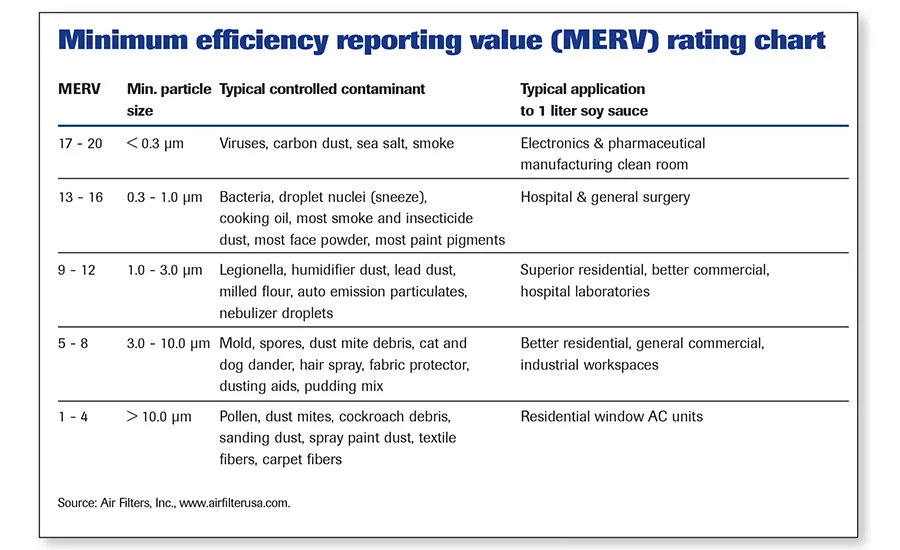Food Safety
Handling the air in your plant
An air-handling system is useless without proper in-plant sanitation. A good handling system is also an essential element of an effective allergen management program.

Processors tend to think much more about traffic patterns than airflow patterns, but they should never underestimate the importance of air management when it comes to producing safe, wholesome foods.
The two citations shown below underscore the importance regulators around the world place on managing air in a food processing facility.
(USFDA [1996], “Current Good Manufacturing Practices in Manufacturing, Packing and Holding Human Food”, Code of Federal Regulations, Title 21 Parts 110, December 18.):
-
4.4.6 Air quality and ventilation
Adequate means of natural or mechanical ventilation should be provided, in particular to:- Minimize airborne contamination of food (e.g., from aerosols and condensation droplets)
- Control ambient temperatures
- Control odors that might affect the suitability of food
- Control humidity, where necessary, to ensure the safety and suitability of food.
-
21 CFR Part 110.20(b)(6)
- Provide adequate ventilation or control equipment to minimize odors and vapors (including steam and noxious fumes) in areas where they may contaminate food; and locate and operate fans and other air-blowing equipment in a manner that minimizes the potential for contaminating food, food packaging materials and food contact surfaces.
Airborne contamination can not only cause foodborne illness, it can contribute to the spoilage of many different foods. For instance, when a Listeria monocytogenes outbreak was attributed to a certain ready-to-eat meat plant, the cause was traced to Listeria that had colonized within a wall. A construction project in the facility failed to properly contain the pathogens which had drifted throughout the facility, contaminating products.
Many years ago, I worked with a fermented sausage processor that experienced sporadic mold spoilage due to wild mold spores that gained access to the plant through the ventilation system. The processor determined the spore ingress was directly related to changes in the prevailing winds. To solve this problem, it installed sensors to close the vents when the wind direction switched from easterly to the west or south.
Air handling also includes controlling air currents caused by pedestrian/equipment traffic and operating equipment. These air currents can cause atomization and microbial cross-contamination as they pass over the stagnant water in drains and drain “p” traps. Consequently, air currents must be considered when a processor is deciding where to locate critical equipment, especially fillers.
The type of air handling and management system a company chooses is a direct function of the type of product it manufactures. For example, low-acid canned foods, carbonated soft drinks and condiments containing high levels of acid are very safe products and not commonly associated with either economic spoilage or foodborne illnesses.
However, sensitive products such as RTE foods (e. g., luncheon meats, cold smoked salmon, dips such as hummus) are prone to post-process contamination with both pathogens and spoilage organisms. To minimize contamination, processors should process and package sensitive items in clean rooms with positive pressure.
Positive pressure is produced by using a battery of air filters. The first should be a coarse filter (often called a “rock and boulder” filter) that captures large particulates and helps protect the second filter, which removes dust particles and even some microorganisms from the air.
For food safety, HEPA filters used in processing operations should be five microns or less. Most are even smaller, in the 15 to 17 MERV (minimum efficiency reporting values) range. The table shown above contains the MERV for different applications.
When using filters, a processor should consider installing pressure differential gauges on them. Filter changes should also be incorporated into the preventive maintenance program. In addition, more frequent checks should be made on pressure gauges to ensure they are operating properly. For instance, a processor might change filters every quarter, but monthly checks will ensure pressure differentials are within expected operating parameters. If the filters need to be changed out earlier, the processor should do so. It is a minor cost compared to those associated with economic spoilage or an outbreak.
In addition, processors must ensure their equipment and environment are kept clean. A good air-handling system is useless without good in-plant sanitation.
Proper air handling also plays an essential role in a company’s allergen management program. This is especially true when working with powders, such as wheat flour, cheese powder or soy flour, since they have a tendency to dust and float everywhere. Therefore, areas where these are present require a different protocol when it comes to air handling. For example, dumping operations for powders or flours should be conducted in a separate room operating under negative pressure.
In the past, the dust was vented to the outside environment, but it often collected on the outside of the ventilation systems, creating a source for a pest infestation. Today, the dust is normally removed through filters and other scrubbers.
As for ventilation, any unit that penetrates the roof of a plant must be designed and located to minimize potential contamination of product. The locations should also allow maintenance without compromising safety or quality.
One red flag regulators and auditors look for is condensate in a plant, especially if it is above or close to where food is handled. Air-handling systems should be designed to minimize such issues, especially in environments where steam is used or during cleanups of cold rooms. Some processors install ventilation systems that are reversible. The process floor operates under positive pressure from HEPA-filtered air during production. During cleanup, the system is reversed to remove steam and warm air to minimize condensate and help dry the area.
Every food processor should look at its products and processes and evaluate potential risks. Processors must design air-handling and allergen management systems to help minimize potential food hazards, whether they are allergens or pathogens.
Looking for a reprint of this article?
From high-res PDFs to custom plaques, order your copy today!




